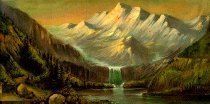 as guardian of the Vedas and Vedic knowledge |
 as guardian of the Vedas and Vedic knowledge |
 |
And then came the great miracle. A miracle that repeated itself and thrilled me each time I crossed over to Tibet; on the highest point of the pass the clouds that in huge masses surged angrily and threateningly dark against the mountain walls, dissolved into thin air as if by magic, the gates of heaven were open, and a world of luminous colours under a deep blue sky stretched before one's eyes and a fierce sun lit up the snow covered slopes on the other side of the pass so that one was almost blinded by their brilliance. Even the deep colors of the shadows seemed to radiate, and the isolated white summer clouds which blissfully floated in the velvety dark blue sky and between the far off purple coloured mountain ranges only enhanced and intensified the feeling of the immensity and depth of space and the luminosity of colours. It was in this moment, when for the first time I set eyes upon the sacred land of Tibet, that I knew that from now on I would follow the Way of the White Clouds. |

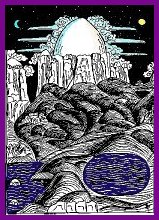 two lakes are situated at the base of the mountain. The higher lake, Manasarovar, is round like the sun, and a lower lake, Rakastal is the shape of the crescent moon. The two lakes represent the solar and the lunar forces respectively. The inner consciousness of man (the solar force) is often compared to the Manasarovar lake. When the thoughts of the mind are stilled, the reflection of the higher Buddhic mind and Atmic awareness is seen. Manas means Mind in Sanskrit. The crescent lake, Rakastal partakes of the lunar or dark forces and this is reflected in the name which comes from Rakshasas or demons; beings who are totally under the sway of the lower desires and impulses (ie lunar forces).
two lakes are situated at the base of the mountain. The higher lake, Manasarovar, is round like the sun, and a lower lake, Rakastal is the shape of the crescent moon. The two lakes represent the solar and the lunar forces respectively. The inner consciousness of man (the solar force) is often compared to the Manasarovar lake. When the thoughts of the mind are stilled, the reflection of the higher Buddhic mind and Atmic awareness is seen. Manas means Mind in Sanskrit. The crescent lake, Rakastal partakes of the lunar or dark forces and this is reflected in the name which comes from Rakshasas or demons; beings who are totally under the sway of the lower desires and impulses (ie lunar forces). Destruction) is said to reside at Mt Kailas. According to tradition Shiva wears the bones of the dead as decoration and smears himself in ash - signifying the burning of the lower desires. The higher significance of the destroyer aspect is that he cuts asunder the bonds of the ego, liberating the Atma within from the darkness of ignorance. Coincident with this theme of death is the presence of two large hollows on Mt Kailas so that from one particular angle, the ice covered dome of Kailas appears as a skull with two large eyeholes peering out from beneath the skull-like dome.
Destruction) is said to reside at Mt Kailas. According to tradition Shiva wears the bones of the dead as decoration and smears himself in ash - signifying the burning of the lower desires. The higher significance of the destroyer aspect is that he cuts asunder the bonds of the ego, liberating the Atma within from the darkness of ignorance. Coincident with this theme of death is the presence of two large hollows on Mt Kailas so that from one particular angle, the ice covered dome of Kailas appears as a skull with two large eyeholes peering out from beneath the skull-like dome.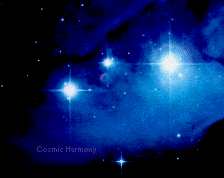 |
Cosmic Harmony  |
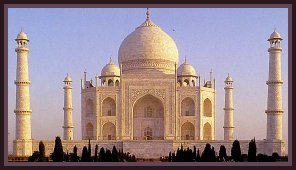 At foot of the Himalayan range lies the ancient land of Bharath - modern day India. The culture of India has been protected by its location, with the Himalayas to the north and the ocean to the southeast and west. Traditionally the people of Bharath have been non violent except in defense of the Motherland. For thousands of years the treasures of the Vedic knowledge have been protected and propagated by the Sages, Saints and Seers of India. From ancient times the cultures of Bharath have held the Vedic teachings in high esteem and have passed them down through time from generation to generation. No other ancient culture has so thoroughly woven the knowledge and methods of enlightenment into the mind and hearts, rites and rituals of its people. Until very recently the children of India were raised hearing elders reciting the stories of the Avatar Rama, or telling of the pranks played in childhood by the Avatar Krishna. Villages enacted plays and sang songs of the heroes from the Puranas, the Bhagavata, and other sacred literature. All of the holidays revolved around Saints or deities. Because of its unique placement and strong traditions all the major Avatars have taken birth in India. Partial incarnations have also arisen from time to time to strengthen or purify the Vedic knowledge. Veda Vyasa for example who codified the Vedas into four major divisions was said to be a Divine incarnation of a realized being. His son, Sri Suka, who related the stories of the Bhagavata to King Parakshith was also a great Sat Purush; always in the pure Atmic state of consciousness. Adi Sankara, the great Indian teacher considered himself a dedicated servant of God. As a child prodigy he learned all of the Vedas and Sastras by the time he was 14 - a feat that normally took 50 years of intense study. He went all over India spreading the teachings of the philosophy of Advaitha - that the entire Universe and everything in it is God, the One without a second. Buddha was also born in India. He attained enlightenment there under the Bodhi tree. After his realization he subsequently taught that all misery is caused by desire for worldly objects and that this wheel of birth and death can be overcome through detachment and the renunciation of desire. The history of India is full of such bright lights.
At foot of the Himalayan range lies the ancient land of Bharath - modern day India. The culture of India has been protected by its location, with the Himalayas to the north and the ocean to the southeast and west. Traditionally the people of Bharath have been non violent except in defense of the Motherland. For thousands of years the treasures of the Vedic knowledge have been protected and propagated by the Sages, Saints and Seers of India. From ancient times the cultures of Bharath have held the Vedic teachings in high esteem and have passed them down through time from generation to generation. No other ancient culture has so thoroughly woven the knowledge and methods of enlightenment into the mind and hearts, rites and rituals of its people. Until very recently the children of India were raised hearing elders reciting the stories of the Avatar Rama, or telling of the pranks played in childhood by the Avatar Krishna. Villages enacted plays and sang songs of the heroes from the Puranas, the Bhagavata, and other sacred literature. All of the holidays revolved around Saints or deities. Because of its unique placement and strong traditions all the major Avatars have taken birth in India. Partial incarnations have also arisen from time to time to strengthen or purify the Vedic knowledge. Veda Vyasa for example who codified the Vedas into four major divisions was said to be a Divine incarnation of a realized being. His son, Sri Suka, who related the stories of the Bhagavata to King Parakshith was also a great Sat Purush; always in the pure Atmic state of consciousness. Adi Sankara, the great Indian teacher considered himself a dedicated servant of God. As a child prodigy he learned all of the Vedas and Sastras by the time he was 14 - a feat that normally took 50 years of intense study. He went all over India spreading the teachings of the philosophy of Advaitha - that the entire Universe and everything in it is God, the One without a second. Buddha was also born in India. He attained enlightenment there under the Bodhi tree. After his realization he subsequently taught that all misery is caused by desire for worldly objects and that this wheel of birth and death can be overcome through detachment and the renunciation of desire. The history of India is full of such bright lights."The wisdom garnered by India, the eldest brother among the nations, is a heritage to all mankind. Vedic truths, as all truths, belongs to the Lord and not to India. The rishis, whose minds were pure receptacles ro receive the divine profundities of the Vedas, were members of the human race, born on this earth, rather than on some other, to serve humanity as a whole. Distinction by race or nation are meaningless in the realm of truth, where the only qualification is spiritual fitness to receive." |
"India does not rise as other countries do, for self or when she is strong, to trample on the weak. She is rising to shed the eternal light entrusted to her over the world. India has always existed for humanity and not for herself and it is for humanity and not for herself that she must be great." |
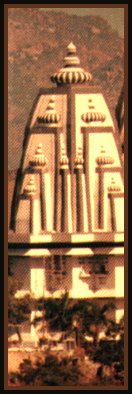 |
"India has been teaching through the ages the message of the spirit and the means to gain and ensure equanimity and joy. she has stood forth as the preceptor of the world for centuries. The prayer that she has taught her people is: "May all people everywhere be happy". This is the consummation of Hindu thought since time immemorial. Such wholesome ideals were propagated and fostered by the rulers of this land, the seers and advanced spiritual aspirants who guided the populace, and the chaste mothers who reared generations in the atmosphere of spiritual effort. The word "Hindu" has been interpreted by scholars in various ways, but the real meaning is him (Himsa or violence) and du (dur, far from); thus, a people who keep away from violence. The Hindu conception of the immanence of God is strong and unshakeable. The rituals, ceremonies, vows, and rites prescribed in Hinduism are all directed to the promotion and well being of "all the worlds". This is the reason that Hinduism is still alive and active. Bharath is the birthplace of the Vedas and of the Sastras, Epics and Puranas that have elaborated the principles enunciated therein for the education of the common man. It is the nursery of music and other fine arts, inspired by the noble passion of consecrating human skills for adoring the Divine and communicating the supersensuous. It is the staff and sustenance of the mystic and the ascetic, the intellectual and the dynamic adorer of God; it is the field where the Science of Yoga (union with God) was cultivated and systematized." |
 |
Story - the King and the SageThere once was a king who led his mighty army across the snowy peaks that bounded his kingdom, into his neighbor's realm. On the lofty pass thick with snow, he saw a mendicant or ascetic sitting on a bare rock, with his head between his knees evidently to protect it from the chill wind that cut across the gap in the peak. He had no clothes on his body. The king was overcome with pity; he took off his own shawl and coat and offered them to the Yogi (ascetic; one who has mastered the senses and the mind). The Yogi refused to accept them, for , he said "God has given enough clothing to guard me against the heat and cold. He gives me all that I need. Please give these to some one who is poor". The King was surprised at these words. he asked him where that clothing was. The Yogi replied "God himself has woven it for me; I am wearing it since birth and will wear it until the grave. Here it is, my skin! Give this coat and shawl to some mendicant beggar, some poor man". The king smiled for, who can be poorer than he, he thought. He asked him, "But where can I find a poor man?" The Yogi asked him , where he was going and why. He said, "I am going into the realm of my enemy so that I can add his kingdom to my own". The Yogi it was who smiled now. He said, "If you are not satisfied with the kingdom you have and if you are prepared to sacrifice your life and the lives of these thousands to get a few more square miles of land, certainly, you are much poorer than I. So offer the clothes to yourself. You need them more than I do". At this the King was greatly ashamed and he understood the futility of fame and fortune. Returning to his own capitol, he thanked the Yogi for opening his eyes to his own innate poverty. Contentment is the most precious treasure, he realised.through their every word and deed. |
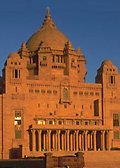 |
 |
|
| <---Back to Cosmic Harmony Home Page |
Forward---> to Bouquet of Religions |